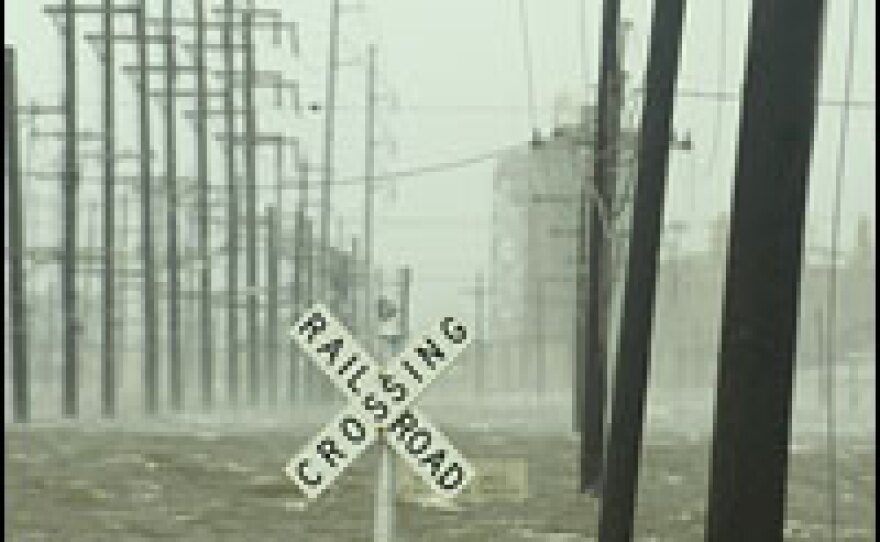


Hurricane Gustav, with winds topping 110 miles per hour, slammed into southern Louisiana Monday morning but with far less fury than feared. The eye of the storm made landfall more than 70 miles west of flood-prone New Orleans.
Gustav, downgraded to a Category 1 by Monday afternoon, was still dumping large amount of rain as it continued its course through Louisiana and into eastern Texas and northern Oklahoma, leaving more than 1 million customers without power.
As the brunt of the hurricane side-stepped New Orleans, city officials were cautiously optimistic that the city's levees would hold back storm surges as the bulging Mississippi River strained several levees.
But waves of water could be seen topping New Orleans' Industrial Canal, and officials in Plaquemines Parish, southwest of the city, were shoring up levees with sandbags.
During Hurricane Katrina, several breaches of the industrial canal led to substantial flooding in the city's central neighborhoods, as well as the Lower Ninth Ward.
The U.S. Army Corps of Engineers said Monday afternoon that the federal flood protection system in New Orleans was holding up.
Government Response
President Bush, eager to show that the mistakes with Hurricane Katrina in 2005 would not be repeated, visited emergency response centers in Texas. Bush was briefed on the federal and state responses to Gustav and said he was happy with the level of coordination.
Texas Gov. Rick Perry said he was closely watching flood conditions in East Texas.
Bush had planned to address the Republican National Convention, but changed plans as Gustav approached.
Oil Production And Supplies
Gustav hit the heart of the Gulf of Mexico's oil and natural gas drilling and production centers. At least half of the U.S. gas refinery capacity is located in the region.
Shell Oil spokesman Shaun Wiggins told NPR that production along the gulf was shut down and 1,400 contract and company personnel were evacuated. Wiggins said the company was waiting until Tuesday to send its fixed-wing aircraft out to assess damage to oil rigs and platforms. But Wiggins said the company's largest platforms have had substantial repairs and upgraded restraints added since hurricanes Katrina and Rita severely damaged operations three years ago.
Exxon and Valero oil companies said production was also significantly scaled back, but that gasoline reserves in the region are sufficient.
That did not seem to reassure Jindal. The governor told reporters at a briefing Monday that 85 percent of gas stations in the southern part of Louisiana were without fuel. Jindal called on the U.S. government to release gasoline from the Strategic Petroleum Reserve. The Department of Energy says only the petroleum industry can make such a request and that a decision on whether to release reserves has not yet been made.
A Large Evacuation
Nearly 2 million people were evacuated from the area where Gustav was expected to hit.
Those who heeded the warnings to get out watched from shelters and hotel rooms hundreds of miles away as the storm bore down on their homes. Gustav did not intensify as forecasters feared, striking the coastline with maximum sustained winds of 110 m.p.h. and weakening as it moved northwest.
Gulf Coast residents have reached evacuation destinations as far north as Tennessee and Missouri. More than 3,000 evacuees arrived at Tennessee Air National Guard bases in Knoxville, Nashville and Memphis.
Memories Of Katrina
The brutal memories of Katrina, which flooded 80 percent of New Orleans and killed more than 1,600 along the Gulf Coast, led officials to insist that everyone in Gustav's path flee from shore. As the storm grew near, the streets of the city were empty, save for members of the National Guard and the city's police force.
According to a city spokesperson only one person has been arrested for looting and the New Orleans Police Department's anti-looting patrol was redeployed Monday afternoon.
After Hurricane Katrina in 2005, more than 100,000 families were left homeless and ended up in travel trailers or mobile homes provided by the Federal Emergency Management Agency. Federal authorities say they won't use the trailers again, unless absolutely necessary, because of concerns about high formaldehyde fumes inside.
New Storms To Watch
Hurricane trackers continue to keep a close eye on Hanna, which they predict could come ashore in Georgia and South Carolina late in the week. FEMA began preparing for Hanna several days ago and has designated a separate group of planners, FEMA's Johnson told The Associated Press.
And Tropical Storm Ike, the ninth named storm of the Atlantic hurricane season, has formed in tropical waters. Ike was about 1,400 miles east of the Leeward Islands at 5 p.m. ET Monday. Its projected course would take it toward the Bahamas over the next several days.
Copyright 2022 NPR. To see more, visit https://www.npr.org. 9(MDAzMjM2NDYzMDEyMzc1Njk5NjAxNzY3OQ001))





